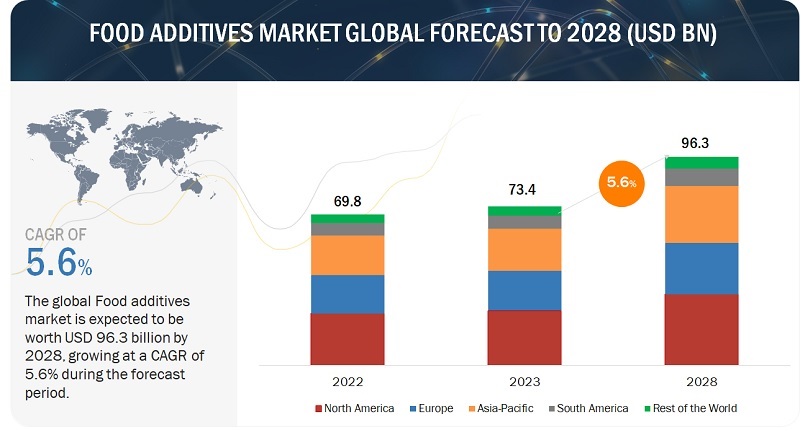The global food additives market is witnessing robust growth, driven by evolving consumer preferences, rising demand for convenience foods, and technological innovations in food processing. Food additives play a crucial role in enhancing flavor, appearance, texture, shelf life, and nutritional value—making them essential across all food categories.
Food Additives Market Forecast
According to MarketsandMarkets, The global food additives market is set to grow from USD 73.4 billion in 2023 to USD 96.3 billion by 2028, at a CAGR of 5.6%.

Food Additives Market Overview
The food additives market is a dynamic sector within the food industry that encompasses a wide range of substances added to food products to enhance their taste, texture, appearance, and shelf life. These additives serve various purposes, including preserving freshness, improving nutritional value, and enhancing flavor and color.
Key drivers shaping the food additives market include:
- Consumer Demand for Convenience: With the growing trend of busy lifestyles and on-the-go consumption habits, consumers are increasingly seeking convenient and ready-to-eat food options. Food additives play a crucial role in extending the shelf life of such products and maintaining their quality during storage and transportation.
- Health and Wellness Trends: Rising health consciousness among consumers has led to a demand for food products with reduced sugar, salt, and fat content. Food additives such as natural sweeteners, low-calorie thickeners, and flavor enhancers enable manufacturers to produce healthier alternatives without compromising taste or texture.
- Technological Advancements: Advances in food science and technology have led to the development of innovative additives that offer improved functionality and performance. For example, encapsulation techniques allow for controlled release of flavors, nutrients, and bioactive compounds in food products, enhancing their sensory appeal and nutritional value.
- Regulatory Framework: Stringent regulations governing the use of food additives, including safety assessments and labeling requirements, influence market dynamics. Manufacturers must comply with regulatory standards to ensure the safety and quality of their products, driving investment in research and development to meet regulatory requirements.
- Shift Towards Natural and Clean Label Ingredients: Growing consumer preference for natural and clean label ingredients has spurred demand for food additives derived from natural sources, such as plant extracts, herbs, and spices. Manufacturers are reformulating their products to replace synthetic additives with natural alternatives to meet consumer expectations for transparency and authenticity.
- Globalization of Food Supply Chains: Increasing globalization of food supply chains has led to greater demand for food additives that improve food safety and extend shelf life, especially in regions with challenging climatic conditions or limited access to fresh produce. Antimicrobial agents, antioxidants, and emulsifiers are examples of additives used to maintain the quality and safety of food products throughout the supply chain.
- Sustainability Concerns: Rising environmental awareness has prompted food manufacturers to explore sustainable alternatives to conventional additives, such as biodegradable packaging materials and eco-friendly processing techniques. Sustainable sourcing practices and waste reduction initiatives are becoming increasingly important considerations in the selection of food additives.
Food Additives Market Opportunities: Advancements in food processing technologies
Advancements in food processing technologies have had a significant impact on the food additives market. The evolution of food processing has enabled the purposeful inclusion of food additives and preservatives in minute quantities to serve specific technological or sensory functions. These functions range from enhancing shelf life and maintaining color to preserving nutritive value and improving flavor. While conventional additives have played a vital role in processing and storage, concerns regarding safety and health have led to a shift towards natural sources such as phytochemicals and plant essential oils as antioxidants and preservatives. The use of metallic nanoparticles as antimicrobial agents and innovative techniques like nanoencapsulation have opened new avenues for developing novel food ingredients. The exploration of non-conventional cell disruption technologies for extracting potential food additives and nutraceuticals from microalgae, along with the use of encapsulated natural compounds as antimicrobial additives in food packaging, exemplifies the industry’s commitment to technological advancements.
Request for Sample Pages: https://www.marketsandmarkets.com/requestsampleNew.asp?id=270
Asia Pacific is poised to experience the highest CAGR in the food additives market during the forecast period.
The region’s remarkable economic growth has led to increased consumer purchasing power, which, in turn, has boosted demand for processed foods and beverages. Food additives play a crucial role in this sector as thickeners, preservatives, stabilizers, and texture enhancers, driving their growth. Additionally, The region’s escalating demand for clean-label products has spurred a surge in the adoption of natural and minimally processed additives, aligning with the global movement towards healthier options. Innovations in plant-based food additives cater to the growing popularity of vegetarian and sustainable dietary choices. The emphasis on health and wellness has elevated the demand for functional additives, addressing specific health concerns and contributing to the region’s overall market growth. Furthermore, the rich tapestry of ethnic and authentic flavors in the Asia Pacific fuels a need for additives that enhance and preserve the unique tastes of regional cuisines. Stringent regulatory compliance and a focus on food safety underscore the importance of compliant and safe food additive solutions in this rapidly growing market.
Top 10 Companies in the Food Additives Market
- Cargill, Incorporated (US)
- BASF SE (Germany)
- ADM (US)
- IFF (US)
- Kerry group plc (Ireland)
- Ingredion Incorporated (US)
- Tate & Lyle (UK)
- Givaudan (Switzerland)
- Darling Ingredients Inc. (US)
- Chr. Hansen Holding A/S (Denmark)
